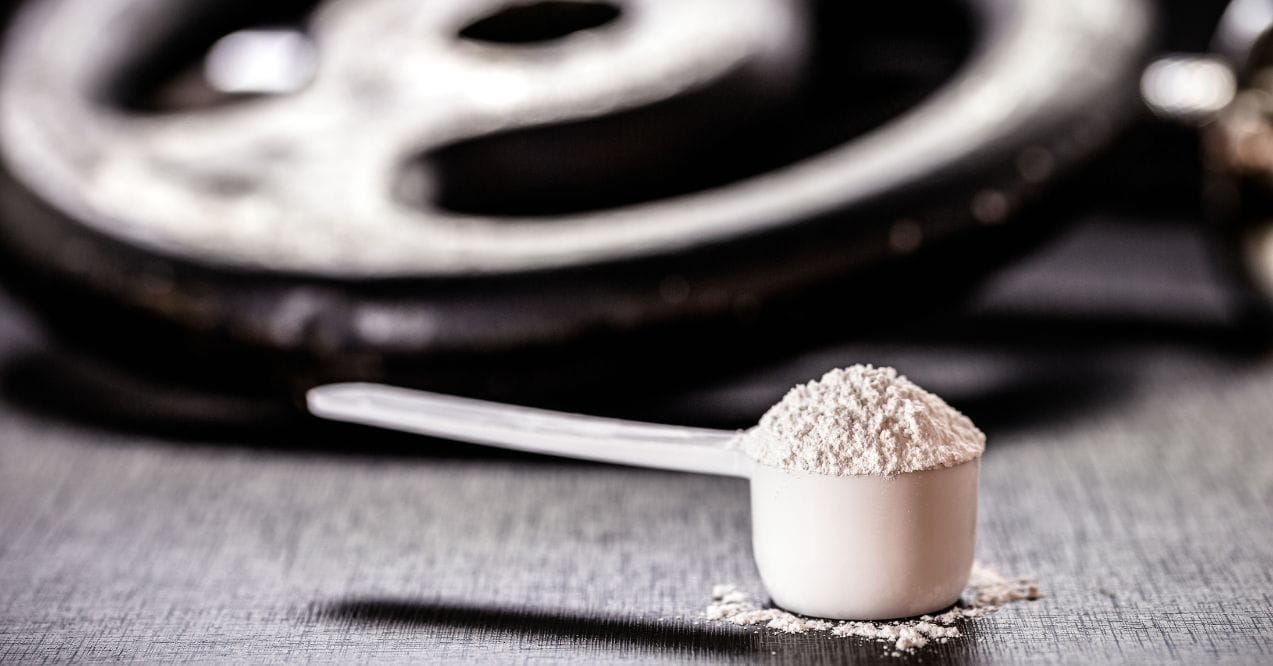Can You Dry Scoop Creatine? Positives, Negatives and Why Others Do It
Can you dry scoop creatine? This question has sparked debates in fitness circles, especially with the rise of social media trends. Dry scooping involves consuming powdered supplements directly, without mixing them with liquid first.
It’s a practice that’s gained attention, particularly among gym enthusiasts looking for quick and efficient ways to take their supplements. Today we dive into the world of dry scooping creatine supplements, exploring its origins, potential benefits, risks, and the reasons behind its popularity.
Key Insights:

What Is Dry Scooping Creatine?
Dry scooping creatine is the act of putting a scoop of creatine powder directly into your mouth and swallowing it without mixing it with water or any other liquid. This trend gained traction on mainstream social media platforms, where fitness influencers showcased this method as a quick way to consume supplements. The practice originated from the bodybuilding community, where some athletes claimed it provided faster results.
However, it’s worth noting that while creatine is a popular supplement, its consumption method can impact its effectiveness and potential side effects. For instance, some users report feeling bloated when taking creatine and that leads us to the question – does creatine make you bloated?
Another common question people ask is whether taking creatine on an empty stomach makes a difference. Some believe that consuming Creatine on an Empty Stomach allows for faster absorption, while others prefer taking it with food to reduce digestive discomfort. Ultimately, the timing and method of consumption matter less than consistency, since creatine works by accumulating in your muscles over time—not by how quickly it enters your system.
Can You Dry Scoop Creatine?
Physically, yes, you can dry scoop creatine. However, the question of whether you should is a different matter entirely. When you dry scoop creatine, you’re essentially bypassing the usual step of mixing it with liquid. This changes how your body processes the supplement.
Creatine is typically absorbed in the small intestine. When mixed with water, it dissolves and is more easily transported through the digestive system. When mixed with water, it dissolves and is more easily transported through the digestive system. If you’re wondering how can I dissolve creatine properly, using warm water or juice can help improve solubility and absorption.
Dry scooping, on the other hand, means the creatine enters your system in a concentrated form.
Your body still needs to break down and dissolve the powder before it can be absorbed. This process might actually slow down absorption compared to taking creatine mixed with water. Speaking of mixing creatine, ever wondered if you can put it in your coffee? Some people do, and while heat isn’t a major issue, stirring well is key to avoiding clumps.
It’s also worth considering that creatine’s effectiveness isn’t about how quickly it enters your system. Creatine works by accumulating in your muscles over time.
Some also wonder, does creatine raise blood pressure? While creatine is widely used for athletic performance and muscle growth, its effects on cardiovascular health continue to be researched. Understanding its overall impact can help you make informed choices about supplementation.
Are There Benefits to Dry Scooping Creatine?

While some fitness enthusiasts swear by dry scooping, the claimed benefits are often more anecdotal than scientific. Let’s explore some of these supposed advantages:
Faster Absorption
One of the main arguments for dry scooping is that it leads to faster absorption. The idea is that by skipping the mixing step, the creatine enters your system more quickly. However, there’s no scientific evidence to support this claim. In fact, as mentioned earlier, your body still needs to dissolve the powder before it can be absorbed, which might actually slow down the process.
Convenience
Dry scooping is often touted as a more convenient method of taking creatine. It eliminates the need for a shaker bottle or water, making it easier to take your supplement on the go. However, this convenience comes at the cost of potential risks and discomfort.
Enhanced Workout Performance
Some users claim that dry scooping creatine gives them an immediate boost in workout performance. This is likely a placebo effect rather than a direct result of the dry scooping method. Creatine’s benefits come from consistent use over time, not from the method of consumption.
It’s worth noting that the timing of creatine consumption isn’t as critical as consistency. Some people might worry about whether taking supplements could interrupt their fasting period. However, creatine is unique in that it doesn’t contain calories or affect our metabolism like food does.
So, Does creatine break a fast? Not in the traditional sense. But if you’re still concerned about maintaining a strict fast, you can always take your creatine during your eating window without losing its benefits.
What Are The Risks To Dry Scooping?

While dry scooping might seem like a quick and easy method, it comes with several potential risks that are important to consider. Is dry scooping creatine bad? The short answer is that it can indeed pose several health risks:
Supplement Wastage
Dry scooping can lead to significant wastage of your supplement. When you put the powder directly in your mouth, it’s easy to spill or cough out some of it. This not only wastes the product but also means you might not be getting your full intended dose.
Inhalation and Choking
One of the most serious risks of dry scooping is the potential for inhalation and choking. When you put a large amount of dry powder in your mouth, it’s easy to accidentally inhale some of it. This can lead to coughing fits and, in severe cases, could cause the powder to enter your lungs, potentially leading to respiratory issues.
Choking is another real risk. The dry powder can clump in your throat, making it difficult to swallow and potentially obstructing your airway. This risk is especially high if you attempt to dry scoop without any water nearby.
Digestive Issues
Consuming concentrated powder can be harsh on your digestive system. It can lead to stomach discomfort, nausea, and even diarrhea in some cases. Your stomach is designed to process food and liquids, not concentrated powders. By dry scooping, you’re essentially asking your digestive system to do extra work to break down and absorb the creatine.
It’s also important to consider what happens if you don’t drink enough water with creatine. Adequate hydration is very important when taking creatine, regardless of the method. Insufficient water intake can lead to dehydration, muscle cramps, and reduced effectiveness of the supplement.
How to Dry Scoop Creatine?
While we don’t recommend dry scooping creatine due to the associated risks, if you choose to do so, here are some guidelines to make it as safe as possible:
- Begin with a smaller amount than your usual dose to see how your body reacts.
- Keep a glass of water nearby to help wash down the powder and prevent choking.
- Take a small sip of water before putting the powder in your mouth. This can help prevent the powder from sticking to your throat.
- Move the powder around in your mouth with your tongue to mix it with saliva before swallowing.
- Don’t try to swallow all the powder at once. Take small amounts and swallow gradually.
- Always drink water after dry scooping to ensure all the powder has been swallowed and to help with digestion.
- Don’t attempt to dry scoop while working out or in situations where choking could be particularly dangerous.
- Regardless of how you take creatine, it’s important to know how much water to drink with creatine. Generally, aim for at least 8-10 glasses of water per day when supplementing with creatine to support proper hydration and muscle function
How to Choose Creatine
When selecting a creatine supplement, it’s important to consider several factors to ensure you’re getting a high-quality product. Here are some key points to keep in mind:
- Look for pure creatine monohydrate – This is the most researched and effective form of creatine.
- Check for third-party testing – This ensures the product meets quality and purity standards.
- Avoid unnecessary additives – The best creatine supplements contain minimal ingredients.
- Consider the manufacturing location: Products made in facilities with strict quality control standards are often superior.
- Opt for micronized creatine – This form dissolves more easily in liquid.
One option that meets these criteria is Trumeta Creatine. It contains 100% Creapure®, which is widely recognized as one of the purest forms of creatine available. Produced in Germany under strict European standards, Trumeta Creatine is free from fillers and is suitable for vegans.

Conclusion
While you can physically dry scoop creatine, the potential risks often outweigh any perceived benefits. The practice doesn’t offer any proven advantages over the traditional method of mixing creatine with water, and it comes with several potential downsides, including choking hazards and digestive issues.
The key to benefiting from creatine supplementation lies in consistent use over time, not in the method of consumption. If you’re looking to optimize your creatine intake, focus on taking it regularly and staying well-hydrated, rather than resorting to potentially risky trends like dry scooping.
When taking creatine, aim for 3-4 liters of water daily. This helps your body properly absorb the supplement and maintain hydration. Drink about 8-16 ounces of water with each 5-gram serving of creatine. Remember, individual needs may vary based on factors like body weight and activity level.
Insufficient water intake while using creatine can lead to dehydration, muscle cramps, and reduced supplement effectiveness. You might experience digestive discomfort, including bloating or stomach upset. Inadequate hydration can also strain your kidneys as they work to process the creatine. Always prioritize proper hydration for optimal results.
Dry scooping creatine can be risky. It may cause choking, lung irritation if inhaled, and digestive discomfort. There’s no proven benefit over mixing with water, and it might lead to supplement wastage. While not inherently dangerous, the potential risks outweigh any perceived advantages. It’s safer and more effective to mix creatine with liquid.
Advertisement. This site offers health, wellness, fitness and nutritional information and is designed for educational purposes only. You should not rely on this information as a substitute for, nor does it replace, professional medical advice, diagnosis, or treatment. If you have any concerns or questions about your health, you should always consult with a physician or other health-care professional. Do not disregard, avoid or delay obtaining medical or health related advice from your health-care professional because of something you may have read on this site. The use of any information provided on this site is solely at your own risk.







